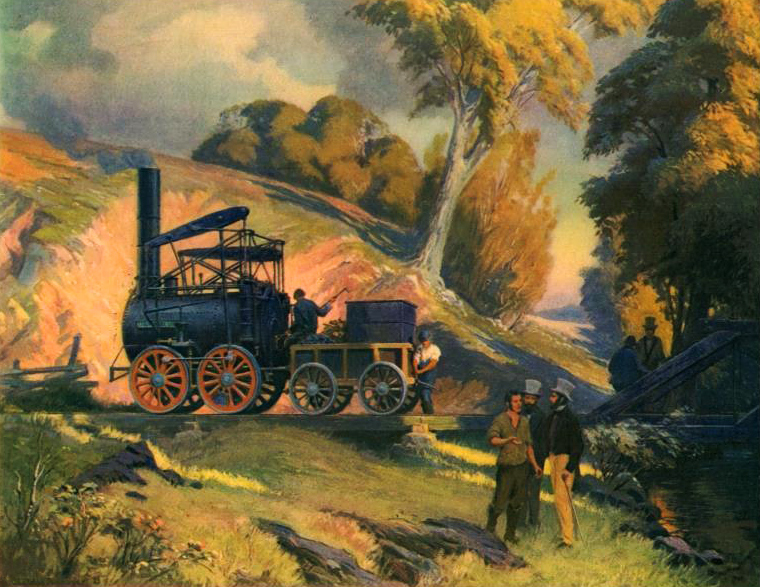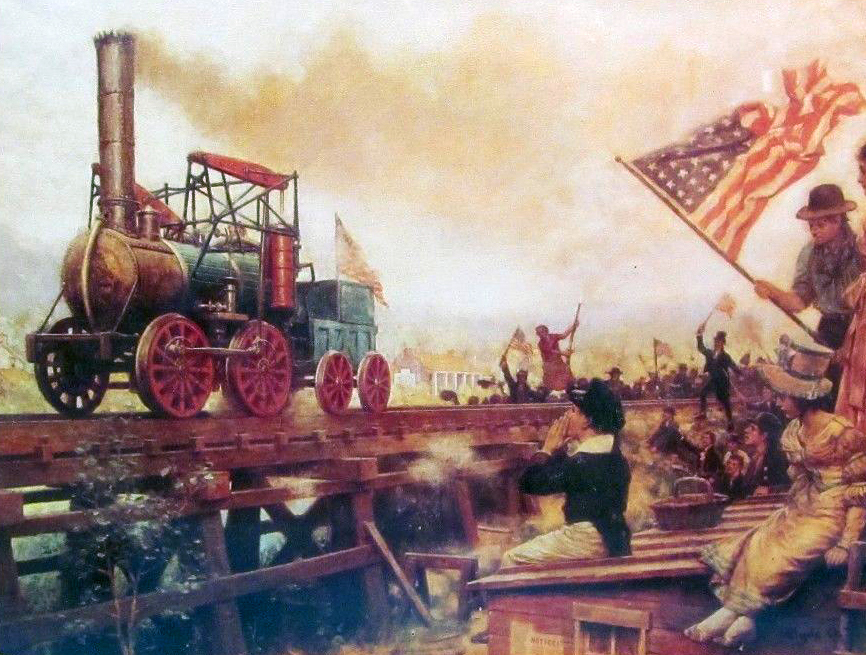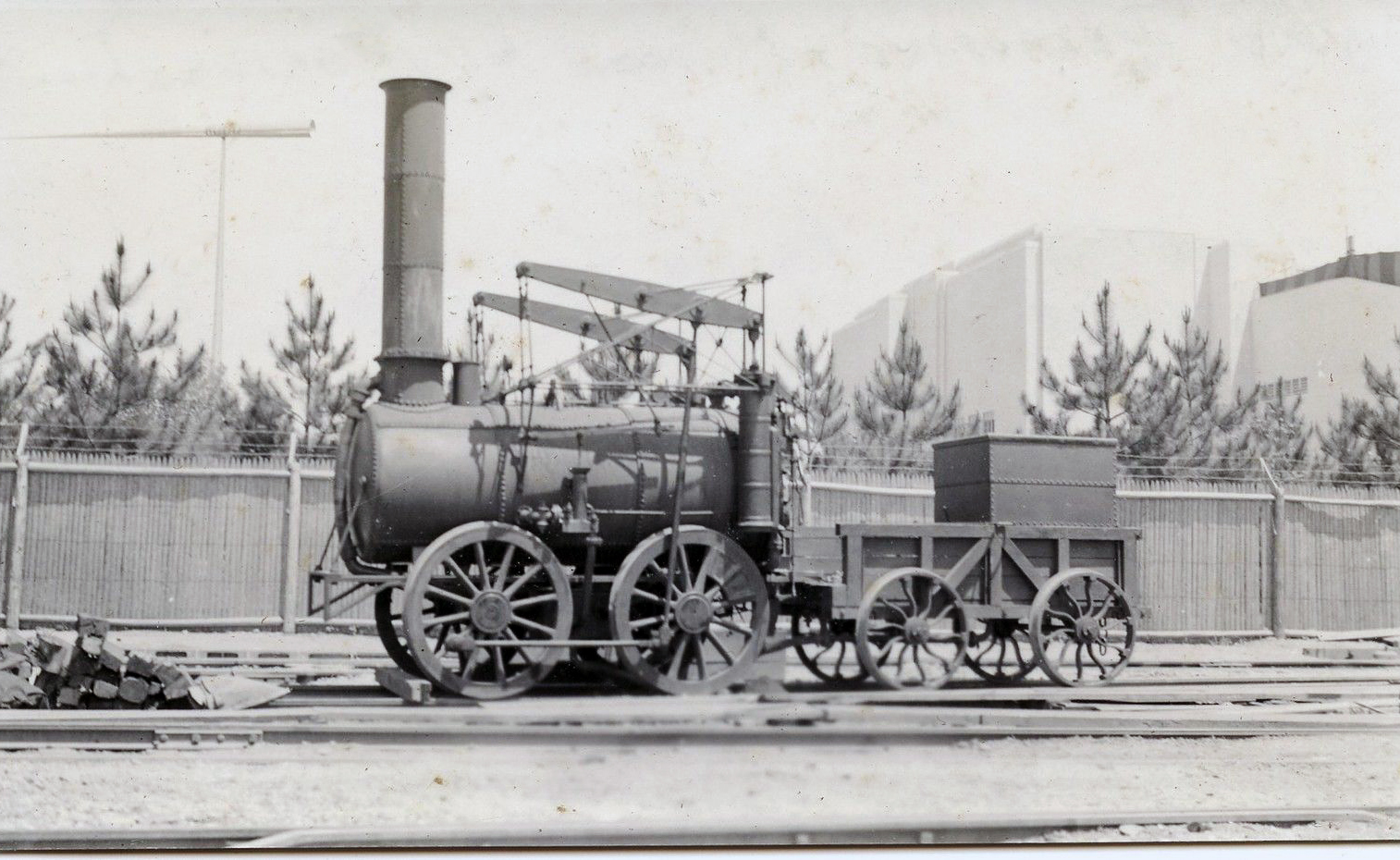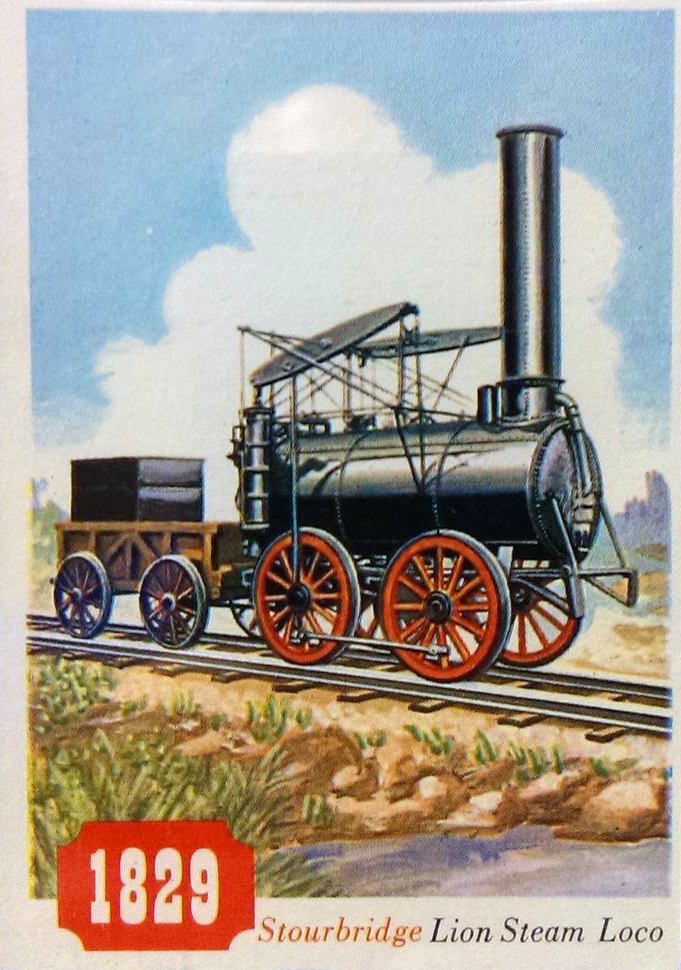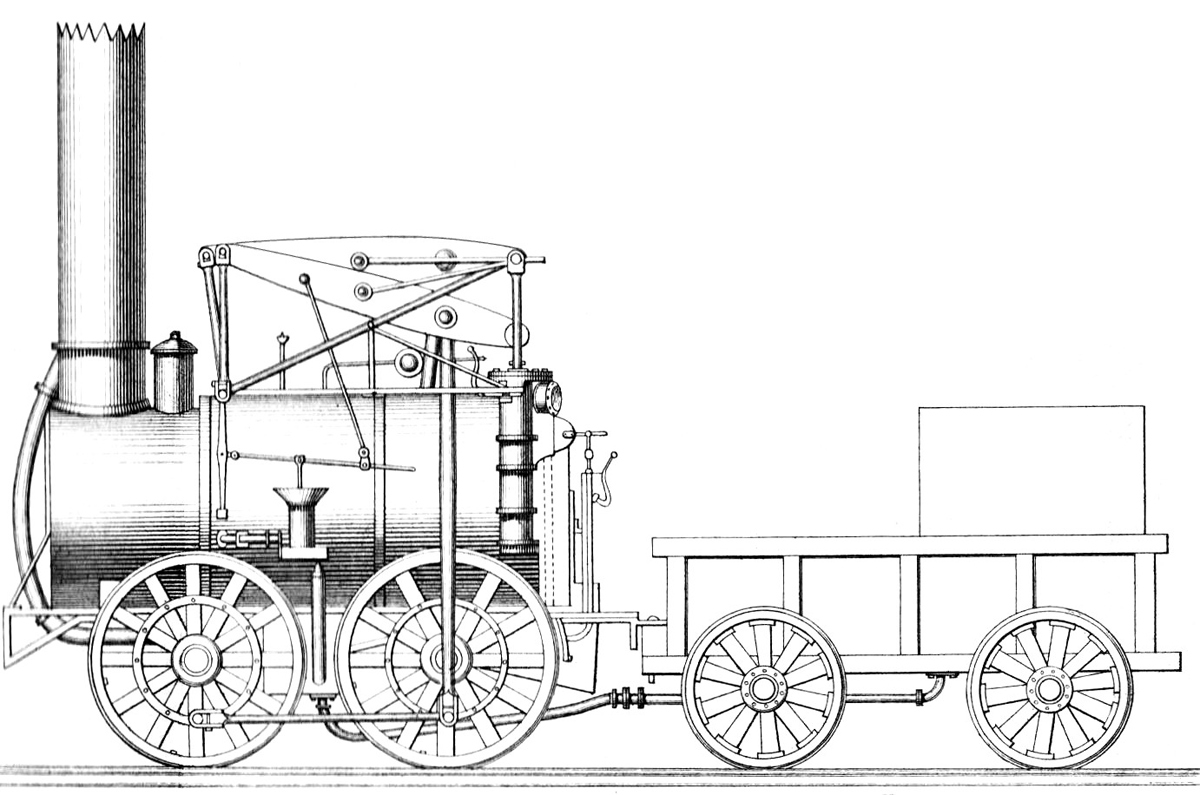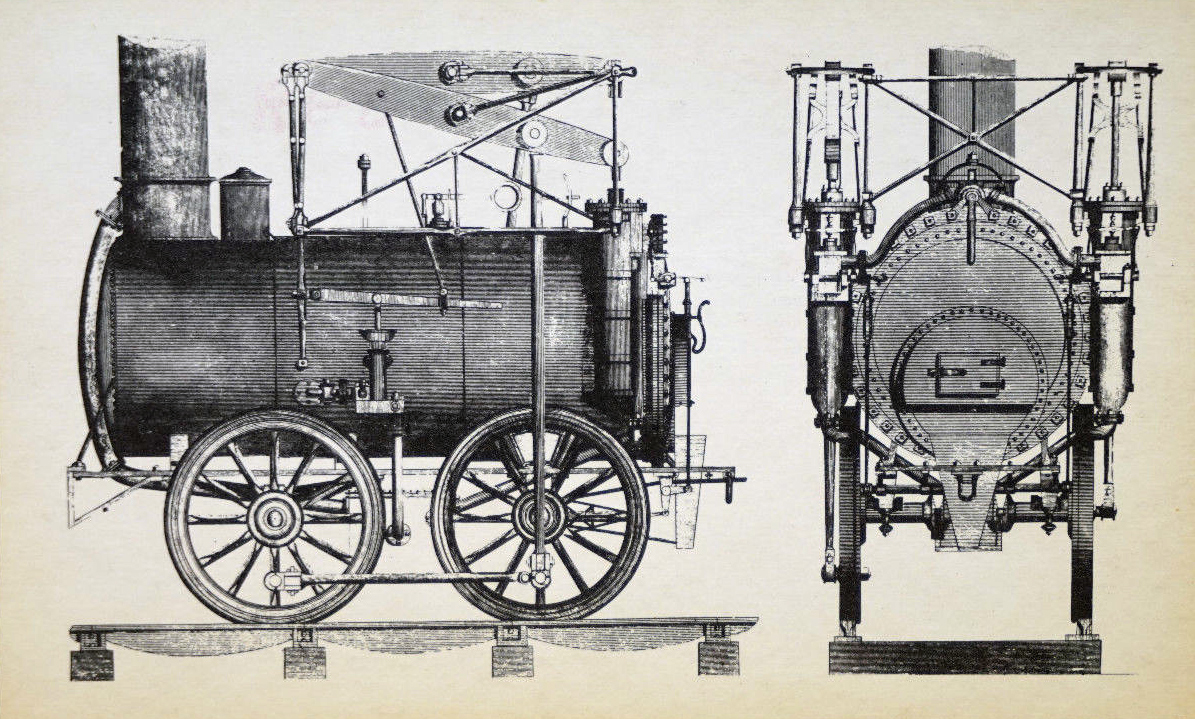"Stourbridge Lion" Locomotive: Facts, History, Photos
Last revised: February 22, 2025
By: Adam Burns
The Stourbridge Lion carries particular importance in American railroad
history as it was the first steam locomotive to be successfully
operated during the summer of 1829, one year prior to the Baltimore
& Ohio's "Tom Thumb", designed by Peter Cooper.
There many "firsts" occurring between 1829 and 1830 in regards to steam power, as it became more and more obvious with each successful test that it was a proven method to move people and goods relatively efficiently and quickly (at least in regards to what was available at the time).
The Lion, purchased by the Delaware & Hudson Canal Company, was not built in the United States but it did prove quite reliable, which is ironic considering after a successful round of testing railroad officials decided against using it.
Soon after its trials the locomotive was put into storage and slowly withered away afterwards through sale and salvage. Luckily, the main boiler survives today and is owned by the Smithsonian Institution although it is on loan to the renowned B&O Museum in Baltimore.
By the 1820s the idea of railroads being a vital mode of transportation in both the United States and England was gaining serious interest. It was the Brits who first successfully developed steam power when Richard Trevithick of England showcased his initial design on February 21, 1804.
By the 1820s a number of horse-powered or incline railways in the U.S. were either in the planning stages or under construction. One of these was the Delaware & Hudson Canal Company that was first chartered in 1823 to move anthracite coal from Carbondale, Pennsylvania to New York City.
The idea was to use a series of incline railroads that operated with stationary steam engines to move loads of coal up and down the mines around Cardondale to the canal located at Honesdale, Pennsylvania. From that point it would then be moved over the water to New York.
During the early 1820s many believed that canals would be the wave of the future in transportation as few gave much thought to the unproven steam locomotive to be either reliable or useful.
The D&H was able to complete its canal that began along Rondout Creek between Kingston and Rosendale, New York and headed southwest to Port Jervis using the Neversink River much of the way.
From there it connected to the Delaware River and traveled due west using the Delaware River and finally the Lackawaxen River to reach Honesdale (as you can see, much of the "canal" was actually just connections to major rivers).
The canal took less than a year to complete and was open by the spring of 1826. That April construction then began on the gravity line, which was its own company named the Delaware & Hudson Gravity Railroad.
By 1829 the planned 16-mile line between Honesdale and Carbondale only was in service for about three miles from Honesdale westward, crossing the Lackawaxen River in the process.
As early as 1827 when the railroad was still in construction the D&H's chief engineer at the time John B. Jervis was very interested in the development of the steam locomotive happening in England.
He decided to send his deputy engineer Horatio Allen to Britain on two missions; one was to purchase strap iron for the railroad and the other was to study the steam locomotives being constructed there.
Interestingly, despite his young age of only 25 Allen was given the responsibility of ordering up to four locomotives if he felt they would prove useful and reliable to the D&H's operations.
Upon arriving in 1828 he met with several builders including the Robert Stephenson & Company and John Urpeth Rastrick of Foster, Rastrick & Company.
He first talked with Robert Stephenson, who, along with his father George were widely regarded as the experts in the field of steam locomotive manufacturing.
Allen decided to place an order with their company for one locomotive, the Pride of Newcastle. However, it was Rastrick's company that received the other three orders and the first unit it completed was the Stourbridge Lion so named for the lion painted on the nose and place were it was built, Stourbridge, England.
While there Allen also ordered the needed strap iron from a foundry in Wolverhampton, 390 tons worth. The cost of the Lion came to $2,914.90 and arrived back in New York on May 13, 1829 disassembled.
It was then sent to the West Point Foundry based in nearby Cold Spring for reassembly in testing. Its initial trials began on August 5, 1829 and proved to be in good working order.
The Stourbridge Lion was designed somewhat differently than the American-built "Tom Thumb" and Best Friend of Charleston which began operating a year later.
It sported the now classic steam design with a horizontal boiler (and vertical smokestack) and driving rods followed by a trailing carriage (tender). Its wheels were built of wood with iron sheathing and featured an 0-4-0 wheel arrangement.
Pistons that sat atop the boiler were driven by steam and were connected to the driving rods which powered the Lion.
Despite the fact that Jervis had requested a locomotive that weighed only 4 tons so that the timber-constructed railroad could support the machine, the Lion weighed nearly 7.5 tons (which became a major issue later).
The locomotive's trial run took place on August 8, 1829 with Allen at the controls. This newfangled machine drew a large attendance to watch the event, many of whom were quite skeptical and fearful that it would explode.
As a result no one would ride the contraption but were stunned and amazed when it took off down the track without a problem and out of sight from the cheering crowd.
It likewise returned without a problem and not only convinced those in attendance of steam's future importance but also in the process entered the history books as the first locomotive ever operated in the United States.
In an odd twist of fate, its weight was too heavy for the track and resulted in D&H officials storing the locomotive instead of spending the necessary upgrades to use it in regular operation. It then sat out of sight after its initial trial run until 1834 when it was sold for its boiler to be used in a local foundry in Carbondale.
After realizing steam was not to be used on the D&H Allen left the company and became chief engineer of the South Carolina Canal And Rail Road a year later in 1830.
What remained of the Stourbridge Lion passed into many hands over the coming years and was eventually acquired by the Smithsonian Institution in 1890.
By that point the remaining boiler had been badly damaged through years of use, neglect, and even vandalism. An attempt to restore the locomotive has been attempted but without knowing what is original the project has never been completed.
Today, the boiler is on loan to the B&O Museum. Also, a replica built by the D&H using the original blueprints resides at the Wayne County Historical Society in Honesdale.
Recent Articles
-
Indiana's Dinner Train Rides In Jasper!
Jan 18, 26 01:54 PM
In the rolling hills of southern Indiana, the Spirit of Jasper offers one of those rare attractions that feels equal parts throwback and treat-yourself night out: a classic excursion train paired with… -
New Mexico's Dinner Train Rides
Jan 18, 26 01:37 PM
If your heart is set on clinking glasses while the desert glows at sunset, you can absolutely do that here—just know which operator offers what, and plan accordingly. -
New Hampshire ~ Murder Mystery ~ Dinner Train Rides
Jan 18, 26 01:10 PM
The state's murder mystery trains stand out as a captivating blend of theatrical drama, exquisite dining, and scenic rail travel. -
New York Valentine's Train Rides
Jan 18, 26 12:32 PM
At its best, the Adirondack Railroad delivers exactly what railfans and casual riders alike hope for: vintage coaches, classic depots, rivers and forests right outside the window. -
Washington Valentine's Train Rides
Jan 18, 26 10:50 AM
Whether you’re a dedicated railfan chasing preserved equipment or a couple looking for a memorable night out, CCR&M offers a “small railroad, big experience” vibe—one that shines brightest on its spec… -
Colorado Valentine's Train Rides
Jan 18, 26 10:49 AM
The Royal Gorge Route Railroad is the kind of trip that feels tailor-made for railfans and casual travelers alike, including during Valentine's weekend. -
Georgia Valentine's Train Rides
Jan 18, 26 10:42 AM
f you’ve ridden the SAM Shortline, it’s easy to think of it purely as a modern-day pleasure train—vintage cars, wide South Georgia skies, and a relaxed pace that feels worlds away from interstates and… -
New Jersey ~ Murder Mystery ~ Dinner Train Rides
Jan 17, 26 01:16 PM
There are currently no murder mystery dinner trains available in New Jersey although until 2023 the Cape May Seashore Lines offered this event. Perhaps they will again soon! -
West Virginia Dinner Train Rides In Elkins!
Jan 17, 26 01:08 PM
The D&GV offers the kind of rail experience that feels purpose-built for railfans and casual travelers. -
Virginia Dinner Train Rides In Staunton!
Jan 17, 26 11:55 AM
If you’ve ever wished you could pair a classic scenic train ride with a genuinely satisfying meal—served at your table while the countryside rolls by—the Virginia Scenic Railway was built for you. -
Florida Easter Train Rides
Jan 17, 26 10:23 AM
The cold weather rarely invades Florida and the state nearly always warm and balmy early spring temperatures. Learn more about where you can find Easter-themed train rides across the Sunshine State. -
Ohio Easter Train Rides
Jan 17, 26 10:13 AM
Ohio is home to several museums and excursion trains preserving the state's rich railroading heritage. A few of these locations host Easter-themed train rides each spring. -
Massachusetts Valentine's Train Rides
Jan 17, 26 09:58 AM
The Cape Cod Central Railroad (CCCR) blends classic New England scenery with heritage equipment, narrated sightseeing, and some of the region’s best-known “rails-and-meals” experiences. -
California Valentine's Train Rides
Jan 17, 26 09:53 AM
Operating out of West Sacramento, this excursion railroad has built a calendar that blends scenery with experiences—wine pours, themed parties, dinner-and-entertainment outings, and seasonal specials… -
South Carolina Dinner Train Rides
Jan 16, 26 11:13 PM
There is only location in the Palmetto State offering a true dinner train experience can be found at the South Carolina Railroad Museum. Learn more here. -
Rhode Island Dinner Train Rides
Jan 16, 26 11:01 PM
Despite its small size, Rhode Island is home to one popular dinner train experience where guests can enjoy the breathtaking views of Aquidneck Island. -
Pennsylvania's Thomas The Train Rides
Jan 16, 26 04:13 PM
"A Day Out With Thomas” train rides offer a unique opportunity for children and their families to engage in a magical and memorable experience, setting the stage for a full day of fun and adventure. -
Illinois's Thomas The Train Rides
Jan 16, 26 02:23 PM
In Illinois, the "A Day Out With Thomas" event offers a unique chance for families to immerse themselves in the enchanting world of Thomas and friends, creating memories that last a lifetime. -
New Jersey's Thomas The Train Rides
Jan 16, 26 02:11 PM
Here's a comprehensive guide to what you can expect at Day Out With Thomas events in New Jersey. -
Texas ~ Murder Mystery ~ Dinner Train Rides
Jan 16, 26 01:54 PM
Here’s a comprehensive look into the world of murder mystery dinner trains in Texas. -
Connecticut ~ Murder Mystery ~ Dinner Train Rides
Jan 16, 26 01:26 PM
All aboard the intrigue express! One location in Connecticut typically offers a unique and thrilling experience for both locals and visitors alike, murder mystery trains. -
New Hampshire Dinner Train Rides In N. Conway!
Jan 16, 26 10:47 AM
Tucked into the heart of New Hampshire’s Mount Washington Valley, the Conway Scenic Railroad is one of New England’s most beloved heritage railways -
Oregon Dinner Train Rides Near Mt. Hood!
Jan 16, 26 10:44 AM
The Mt. Hood Railroad is the moving part of that postcard—a century-old short line that began as a working railroad. -
Maryland's - Wine Tasting - Train Rides
Jan 15, 26 02:59 PM
This article delves into the enchanting world of wine tasting train experiences in Maryland, providing a detailed exploration of their offerings, history, and allure. -
Colorado's - Wine Tasting - Train Rides
Jan 15, 26 02:46 PM
To truly savor these local flavors while soaking in the scenic beauty of Colorado, the concept of wine tasting trains has emerged, offering both locals and tourists a luxurious and immersive indulgenc… -
Iowa ~ Wine Tasting ~ Train Rides
Jan 15, 26 02:36 PM
The state not only boasts a burgeoning wine industry but also offers unique experiences such as wine by rail aboard the Boone & Scenic Valley Railroad. -
Georgia's Wine Train Rides In Cordele!
Jan 15, 26 02:26 PM
While the railroad offers a range of themed trips throughout the year, one of its most crowd-pleasing special events is the Wine & Cheese Train—a short, scenic round trip designed to feel like a t… -
Indiana ~ Murder Mystery ~ Dinner Train Rides
Jan 15, 26 02:22 PM
This piece explores the allure of murder mystery trains and why they are becoming a must-try experience for enthusiasts and casual travelers alike. -
Ohio ~ Murder Mystery ~ Dinner Train Rides
Jan 15, 26 02:10 PM
The murder mystery dinner train rides in Ohio provide an immersive experience that combines fine dining, an engaging narrative, and the beauty of Ohio's landscapes. -
Nevada Dinner Train Rides In Ely!
Jan 15, 26 02:01 PM
If you’ve ever wished you could step through a time portal into the hard-working world of a 1900s short line the Nevada Northern Railway in Ely is about as close as it gets. -
Michigan Dinner Train Rides In Owosso!
Jan 15, 26 09:46 AM
The Steam Railroading Institute is best known as the home of Pere Marquette #1225 and even occasionally hosts a dinner train! -
Arizona's - Wine Tasting - Train Rides
Jan 14, 26 02:04 PM
For those who want to experience the charm of Arizona's wine scene while embracing the romance of rail travel, wine tasting train rides offer a memorable journey through the state's picturesque landsc… -
Arkansas's - Wine Tasting - Train Rides
Jan 14, 26 01:57 PM
This article takes you through the experience of wine tasting train rides in Arkansas, highlighting their offerings, routes, and the delightful blend of history, scenery, and flavor that makes them so… -
Tennessee ~ Murder Mystery ~ Dinner Train Rides
Jan 14, 26 01:42 PM
Amidst the rolling hills and scenic landscapes of Tennessee, an exhilarating and interactive experience awaits those with a taste for mystery and intrigue. -
California ~ Murder Mystery ~ Dinner Train Rides
Jan 14, 26 01:26 PM
When it comes to experiencing the allure of crime-solving sprinkled with delicious dining, California's murder mystery dinner train rides have carved a niche for themselves among both locals and touri… -
Illinois ~ Murder Mystery ~ Dinner Train Rides
Jan 14, 26 01:13 PM
Among Illinois's scenic train rides, one of the most unique and captivating experiences is the murder mystery excursion. -
Vermont's - Murder Mystery - Dinner Train Rides
Jan 14, 26 12:57 PM
There are currently murder mystery dinner trains offered in Vermont but until recently the Champlain Valley Dinner Train offered such a trip! -
Massachusetts Dinner Train Rides On Cape Cod!
Jan 14, 26 12:20 PM
The Cape Cod Central Railroad (CCCR) has carved out a special niche by pairing classic New England scenery with old-school hospitality, including some of the best-known dining train experiences in the… -
Maine Dinner Train Rides In Portland!
Jan 14, 26 11:31 AM
While this isn’t generally a “dinner train” railroad in the traditional sense—no multi-course meal served en route—Maine Narrow Gauge does offer several popular ride experiences where food and drink a… -
Kentucky Dinner Train Rides In Bardstown!
Jan 13, 26 01:14 PM
The essence of My Old Kentucky Dinner Train is part restaurant, part scenic excursion, and part living piece of Kentucky rail history. -
Kansas Dinner Train Rides In Abilene!
Jan 13, 26 12:44 PM
If you’re looking for a heritage railroad that feels authentically Kansas—equal parts prairie scenery, small-town history, and hands-on railroading—the Abilene & Smoky Valley Railroad (A&SV) delivers. -
Michigan ~ Murder Mystery ~ Dinner Train Rides
Jan 13, 26 11:24 AM
Among the lesser-known treasures of this state are the intriguing murder mystery dinner train rides—a perfect blend of suspense, dining, and scenic exploration. -
Virginia's - Murder Mystery - Dinner Train Rides
Jan 13, 26 11:11 AM
Among the state's railroad attractions, murder mystery dinner trains stand out as a captivating fusion of theatrical entertainment, fine dining, and scenic travel. -
Arizona Dinner Train Rides At The Grand Canyon!
Jan 13, 26 10:59 AM
While the Grand Canyon Railway does not offer a true, onboard dinner train experience it does offer several upscale options and off-train dining. -
Georgia Dinner Train Rides In Nashville!
Jan 13, 26 10:27 AM
If you’ve ever wished you could slow down, trade traffic for jointed rail, and let a small-town landscape roll by your window while a hot meal is served at your table, the Azalea Sprinter delivers tha… -
Indiana Valentine's Train Rides
Jan 12, 26 04:27 PM
If you’ve ever wished you could step into a time when passenger trains were a Saturday-night treat and a whistle echoing across farm fields meant “adventure,” the Nickel Plate Express delivers that fe… -
Ohio Valentine's Train Rides!
Jan 12, 26 04:20 PM
The Hocking Valley Scenic Railway offers one of the region’s most atmospheric ways to experience the Hocking Hills area: from the rhythmic click of jointed rail to the glow of vintage coaches rolling… -
Wisconsin's - Wine Tasting - Train Rides
Jan 12, 26 03:10 PM
Wisconsin might not be the first state that comes to mind when one thinks of wine, but this scenic region is increasingly gaining recognition for its unique offerings in viticulture. -
California's - Wine Tasting - Train Rides
Jan 12, 26 02:34 PM
This article explores the charm, routes, and offerings of these unique wine tasting trains that traverse California’s picturesque landscapes. -
Wisconsin Scenic Train Rides In North Freedom!
Jan 12, 26 02:20 PM
The Mid-Continent Railway Museum is a living-history museum built around the sights, sounds, and everyday rhythms of small-town and shortline railroading in the early 20th century, what the museum cal…

